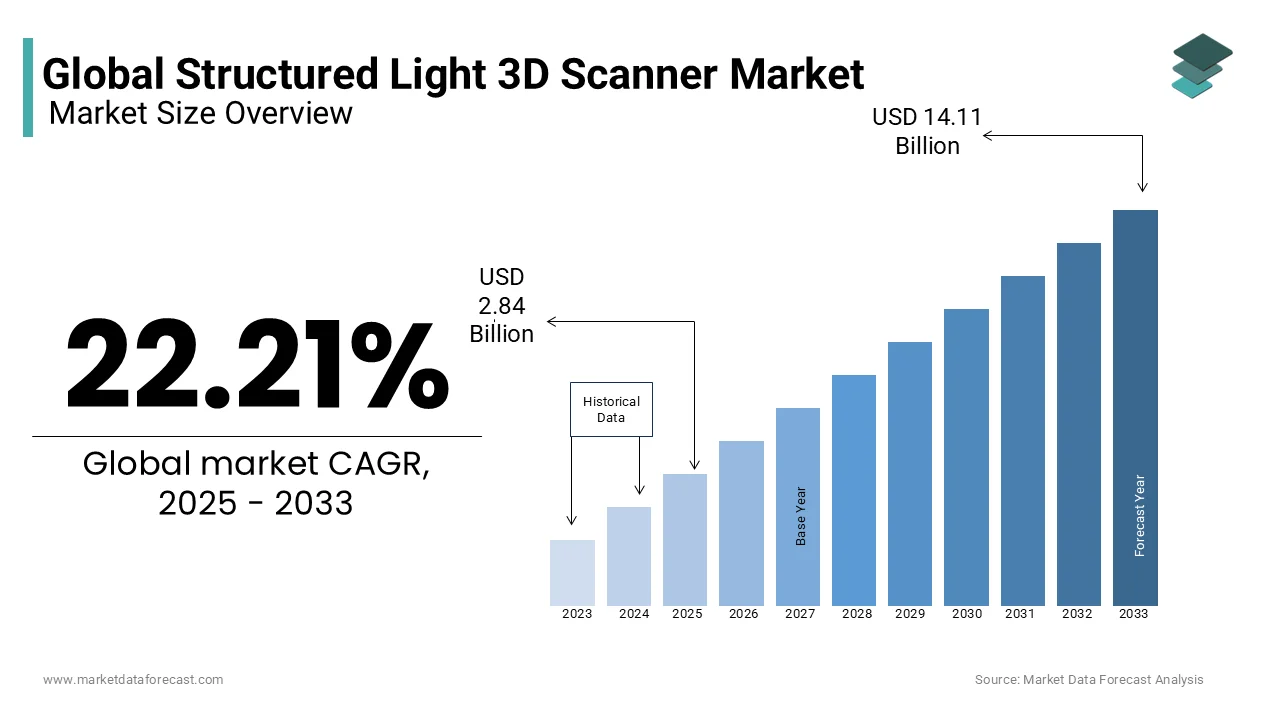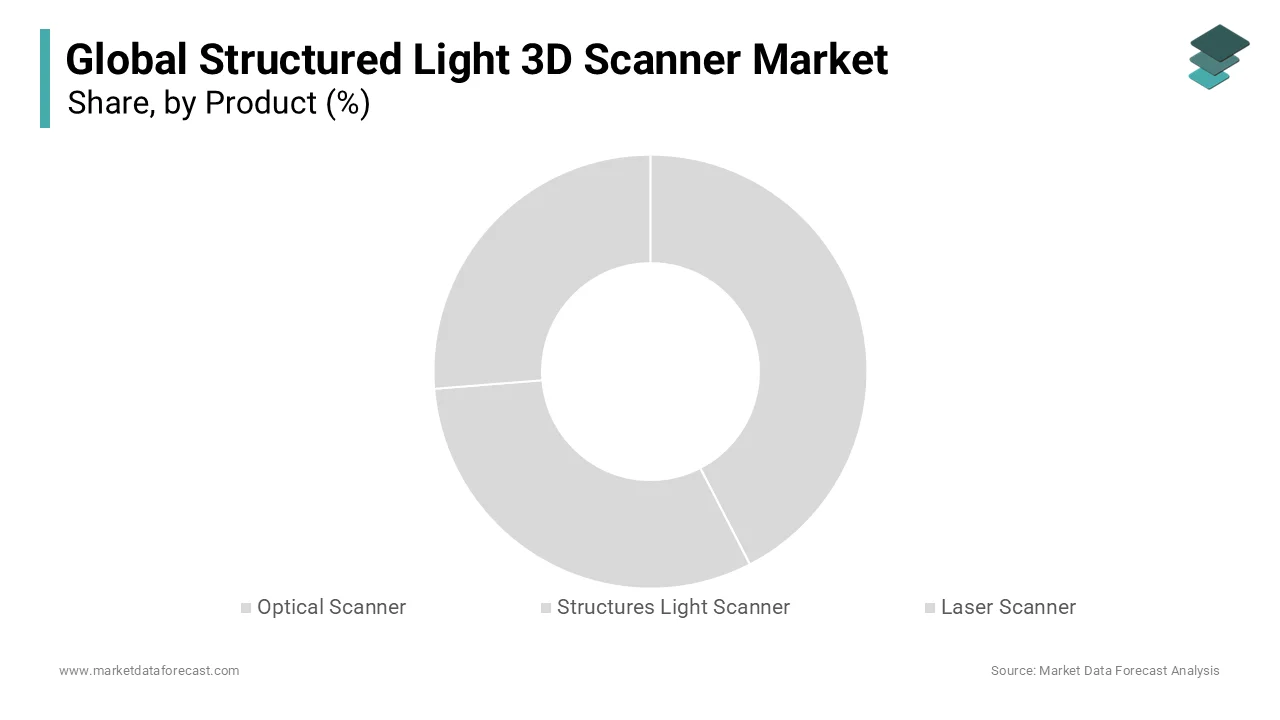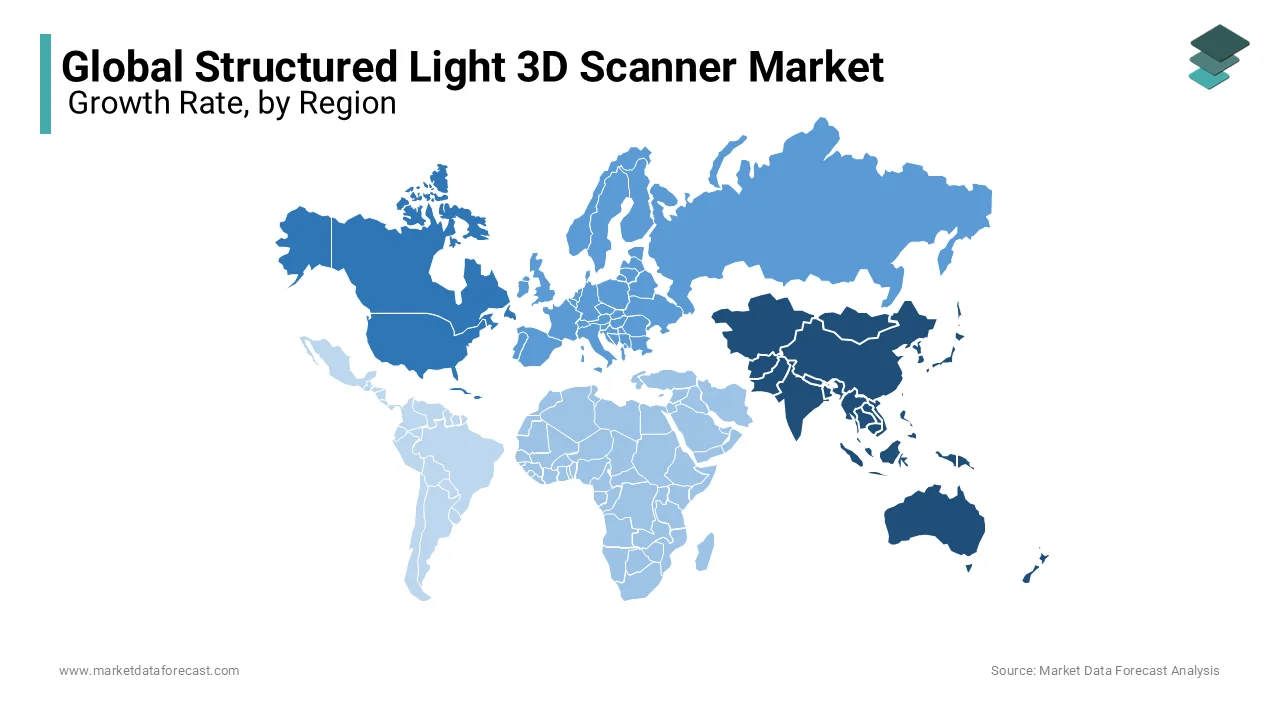Global Structured Light 3D Scanner Market Size, Share, Trends, & Growth Forecast Report By Product Type (Optical Scanner, Light Scanner and Structured Light Scanner), Range, Application, Component, Scanner Type, End-user, and Region (North America, Europe, Asia Pacific, Latin America, and Middle East & Africa), Industry Analysis From 2024 to 2033
Global Structured Light 3D Scanner Market Size
The global structured light 3D scanner market was valued at USD 2.32 billion in 2024. The global market is projected to grow at a CAGR of 22.21% from 2025 to 2033 and be worth USD 14.11 billion by 2033 from USD 2.84 billion in 2025.

3D scanners are devices used to capture the details of real-world objects that include properties such as texture, and color which can be used to produce a 3D object. The automotive industry also uses this 3D scanner to check quality control and to inspect the applications whether the components are manufactured within the specified levers or not.
As the number of applications is increasing, the market is also expected to have rapid growth. These 3D scanners are among the innovations that have changed the world. Across the major end-user industries, the 3D scanner has been witnessing commercial applications. The usage of 3D scanners provides quality control of small and big components of manufacturing and production. The end-users use the Structured Light 3D Scanner for various purposes. As for health care, the 3D scanner is used to generate the body implantation and to model the body parts in three dimensional. To enhance the quality of the product, this technology is preferred as it saves time, cost and effort during the process of production. 3D scanning has become popular across the major end-user industries, by customizing the technology to meet professional needs in various streams. Cost is one of the critical factors that restrain the rise in adoption of 3D Scanners.
MARKET DRIVERS
The increasing applications in automotive and aerospace designing drive the global structured light 3D scanner market.
The increase in the number of wearable devices makes the human- techno interaction more realistic to the world and immersive. These technologies made data capturing very easy and fast. A considerable amount of 3D data is being used nowadays, which is used to define a product for inspection. The significant factors that drive the 3D scanners market are reduced manufacture time and the rise in adoption of 3D Scanner to improve the quality of the product.
The increase in the adoption of 3D scanning material in industries like aerospace, defense, and healthcare, is likely to drive the global structured light 3D scanner market during the forecast period. There are cost-effective alternatives to 3D scanning. Although the 3D scanners provide us with quick and accurate scanning, the cost-effective alternative is restraining the growth of the target market.
REPORT COVERAGE
|
REPORT METRIC |
DETAILS |
|
Market Size Available |
2024 to 2033 |
|
Base Year |
2024 |
|
Forecast Period |
2025 to 2033 |
|
CAGR |
22.21% |
|
Segments Covered |
By Product, Range, Application, Type, End User, Component, and Region |
|
Various Analyses Covered |
Global, Regional & Country Level Analysis, Segment-Level Analysis, DROC, PESTLE Analysis, Porter’s Five Forces Analysis, Competitive Landscape, Analyst Overview of Investment Opportunities |
|
Regions Covered |
North America, Europe, APAC, Latin America, Middle East & Africa |
|
Market Leaders Profiled |
Hexagon AB (Sweden), FARO Technologies, Inc. (US), Nikon Metrology NV (Belgium), Trimble Inc. (US), Topcon Corporation (Japan),3D Systems Corporation (US), Perceptron Inc. (US), Kreon Technology (France), Shapegrabber (Canada), Fuel 3D (UK), Arctec 3D (Luxemburg), Next Engine (California), Shining 3D Tech (China), RangeVision (Russia), Exact Metrology (US), Trimet (US),3D Scanco (US), Maptek Pty Ltd (US), True Point Laser Scanning LLC (US), Basis Software Inc. (US), Capture 3D (California), Creaform, Inc. (Canada) and Others. |
SEGMENTAL ANALYSIS
By Product Insights
The structured light scanner is regarded to grow significantly. With a stable light uniform electron flow such as LEDs.

By Range Insights
Short-range 3D holds the most substantial share value with low cost and brings awareness to designing the product, modeling, and material inspection.
By Application Insights
Quality control & inspection has a large share of market value which is caused by bringing awareness about advanced medical treatment and also there is a need to capture a large amount of 3D data analysis.
By Type Insights
Fixed CMM-based has a significant share value where it captures the entire object from different angles from a fixed location. This is also one of the factors that drive demand.
The portable CMM-based segment is projected to have promising growth through the foreseen period. These scanners are versatile and flexible when compared to 3D scanners and capture objects of various sizes in three dimensions.
By End-User Insights
In the global structured light 3D scanner market, automotive holds the larger share of market value where it is attributed to obtaining the processing of material, material inspection, manufacturing and designing of automotive.
By Component Insights
Hardware holds the most considerable share value because of the increasing demand for a 3D scanner for printing and imaging applications.
REGIONAL ANALYSIS
In the regional segmentation of the global structured light 3D scanner market, the Asia-Pacific (APAC) is anticipated to have immense growth opportunities from the automotive and architectural sectors over the forecast period. The 3D scan is used in several areas like dentistry, civil, architecture, quality archaeology, and dimensional mechanical inspection. This region comprises developing economies such as India and China. In APAC, there are some significant factors that drive the growth of the 3D scanner market such as the rise in the number of engineering and infrastructure projects, to ensure better and faster recovery and also the growth of dental restoration surgeries in APAC.

KEY PLAYERS IN THE MARKET
Companies playing a major role in the global structured 3D scanner market include Hexagon AB (Sweden), FARO Technologies, Inc. (US), Nikon Metrology NV (Belgium), Trimble Inc. (US), Topcon Corporation (Japan), 3D Systems Corporation (US), Perceptron Inc. (US), Kreon Technology (France), Shapegrabber (Canada), Fuel 3D (UK), Arctec 3D (Luxemburg), Next Engine (California), Shining 3D Tech (China), RangeVision (Russia), Exact Metrology (US), Trimet (US), 3D Scanco (US), Maptek Pty Ltd (US), True Point Laser Scanning LLC (US), Basis Software Inc. (US), Capture 3D (California) and Creaform, Inc. (Canada).
RECENT HAPPENINGS IN THE MARKET
-
FARO introduces Cobalt Design 3D Scanning Solution. This has been combined with recently added RevEng, a software platform where small to medium objects are scanned with precision, with multiple levels of resolution. This Cobalt Design is specially created for design applications, jewelry and fashion design and is ideal for scanning complex surfaces.
-
SHINING 3D’s Free Scan X5 3D scanner helps Student Formula racing team improve the housing structure. The students of the DHBW Engineering Stuttgart eV selected to scan this year’s monocoque using SHINING 3D’s handheld laser 3D scanner, the FreeScan X5.
-
Hexagon Manufacturing Intelligence has launched PartInspect L, the first automated 3D measurement cell product based on AICON scanner technology. To meet the demand for increased high-speed, high-quality measurement and analysis, PartInspect L uses advance automation expertise.
MARKET SEGMENTATION
This research report on the global structured light 3D scanner market has been segmented and sub-segmented based on product, range, application, type, end user, component, and region.
By Product
- Optical Scanner
- Structures Light Scanner
- Laser Scanner
By Range
- Short Range
- Medium Range
- Long Range
By Application
- Reverse Engineering
- Quality Control & Inspection
- Virtual Simulation
- Face/Body Scanning
- Others
By Type
- Tripod Mounted
- Fixed CMM Based
- Portable CMM Based
- Desktop
By End-User
- Aerospace & Defence
- Healthcare
- Architecture & Construction
- Entertainment & Media
- Automotive
- Others
By Component
- Hardware
- Software
- Services
By Region
- North America
- Europe
- Asia-Pacific
- South America
- Middle East & Africa
Frequently Asked Questions
What are the key drivers of growth in the Structured Light 3D Scanner Market?
The key drivers include increasing demand for precise and accurate 3D models in industries like automotive and aerospace, advancements in 3D scanning technologies, rising adoption of 3D scanning in healthcare, and the growing use of 3D printing, which requires detailed 3D models.
What industries are the primary users of structured light 3D scanners?
The primary industries include automotive, aerospace, healthcare, consumer electronics, and manufacturing. These scanners are widely used for quality control, reverse engineering, rapid prototyping, and in medical applications such as orthotics and prosthetics design.
What technological advancements are shaping the Structured Light 3D Scanner Market?
Key advancements include the integration of AI and machine learning for improved data processing, the development of portable and handheld devices, enhanced resolution and speed, and better software for easier post-processing of 3D data.
What is the future outlook for the Structured Light 3D Scanner Market?
The market is expected to continue growing due to increasing applications in emerging fields like virtual reality, augmented reality, and cultural heritage preservation. The ongoing reduction in costs and improvements in technology are likely to make these scanners more accessible to a broader range of industries.
Related Reports
Access the study in MULTIPLE FORMATS
Purchase options starting from $ 2500
Didn’t find what you’re looking for?
TALK TO OUR ANALYST TEAM
Need something within your budget?
NO WORRIES! WE GOT YOU COVERED!
Call us on: +1 888 702 9696 (U.S Toll Free)
Write to us: [email protected]